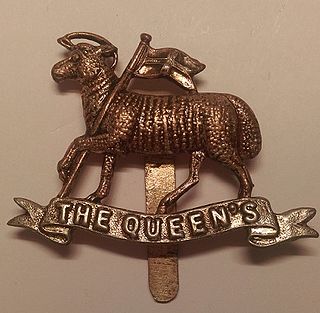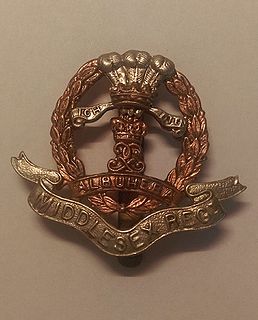
The 8th Infantry Division was an infantry division of the British Army that was active in both the First and Second World Wars. The division was first formed in October 1914 during the First World War, initially consisting mainly of soldiers of the Regular Army and served on the Western Front throughout the war, sustaining many casualties, before disbandment in 1919. The division was reactivated in Palestine, under the command of Major-General Bernard Montgomery, in the late 1930s in the years running up to the Second World War before being disbanded in late February 1940. It was briefly reformed in Syria in an administrative role during 1942-3.

The Post Office Rifles was a unit of the British Army, first formed in 1868 from volunteers as part of the Volunteer Force, which later became the Territorial Force. The unit evolved several times until 1921, after which the name was lost during one of many reorganisations.

The 47th Division was an infantry division of the British Army, raised in 1908 as part of the Territorial Force.

The Royal Irish Rifles was an infantry rifle regiment of the British Army, first created in 1881 by the amalgamation of the 83rd Regiment of Foot and the 86th Regiment of Foot. The regiment saw service in the Second Boer War, the First World War, the Second World War, and the Korean War.

The Cameronians was a rifle regiment of the British Army, the only regiment of rifles amongst the Scottish regiments of infantry. It was formed in 1881 under the Childers Reforms by the amalgamation of the 26th Cameronian Regiment and the 90th Perthshire Light Infantry. In 1968, when reductions were required, the regiment chose to be disbanded rather than amalgamated with another regiment, one of only two infantry regiments in the British Army to do so, with the other being the York and Lancaster Regiment. It can trace its roots to that of the Cameronians, later the 26th of Foot, who were raised in 1689. The 1881 amalgamation coincided with the Cameronian's selection to become the new Scottish Rifles.

The Queen's Royal Regiment was a line infantry regiment of the English and later the British Army from 1661 to 1959. It was the senior English line infantry regiment of the British Army, behind only the Royal Scots in the British Army line infantry order of precedence.
The 16th Infantry Brigade was an infantry brigade of the British Army that saw active service during the Second Boer War and the First and Second World Wars.
The 131st Infantry Brigade, originally the Surrey Brigade was an infantry formation of Britain's Territorial Army that saw service during both the First and the Second World Wars. In the First World War the brigade was in British India for most of the war and did not see service as a complete unit but many of its battalions would see service in the Middle East.
The 25th Infantry Brigade was a war-formed infantry brigade of the British Army that saw active service during both the First and the Second World Wars.

The Middlesex Regiment was a line infantry regiment of the British Army in existence from 1881 until 1966. The regiment was formed, as the Duke of Cambridge's Own , in 1881 as part of the Childers Reforms when the 57th and 77th Regiments of Foot were amalgamated with the county's militia and rifle volunteer units.

The Indian Army during World War I contributed a large number of divisions and independent brigades to the European, Mediterranean, Middle East and African theatres of war in World War I. Over one million Indian troops served overseas, of whom 62,000 died and another 67,000 were wounded. In total at least 74,187 Indian soldiers died during the war.

Eric Henri Kennington was an English sculptor, artist and illustrator, and an official war artist in both World Wars.

The 107th Infantry Regiment was a regiment of the New York Army National Guard. The regiment was formed in 1917 and disestablished in 1993.
The 142nd Brigade was an infantry brigade of the Territorial Army, part of the British Army, that served in the First and the Second World Wars, and remained in the United Kingdom throughout the latter.
The 169th Brigade was an infantry brigade of the British Army that saw active service in both the First and the Second World Wars. Throughout its existence the brigade, serving under numerous many different titles and designations, was an integral part of the 56th (London) Infantry Division. It served on the Western Front in the First World War, and in the North African and Italian campaigns during the Second World War.
The Leeds Rifles was a unit of the 19th century Volunteer Force of the British Army that went on to serve under several different guises in the World Wars of the 20th century. In World War I both battalions served as infantry on the Western Front and was later were converted into an anti-aircraft and tank unit, fighting in North Africa, Italy and Burma during World War II.

The 1st Surrey Rifles was a volunteer unit of the British Army from 1859 until 1993. It saw considerable service on the Western Front, at Salonika and in Palestine during World War I. It served as a searchlight unit and as a light anti-aircraft regiment during World War II.

The Civil Service Rifles War Memorial is a First World War memorial located on the riverside terrace at Somerset House in central London, England. Designed by Sir Edwin Lutyens and unveiled in 1924, the memorial commemorates the 1,240 members of the Prince of Wales' Own Civil Service Rifles regiment who were killed in the First World War. They were Territorial Force reservists, drawn largely from the British Civil Service, which at that time had many staff based at Somerset House.

24th Battalion was a battalion of the London Regiment (1908-1938). Between 1908 and 1938 it was based at the Braganza Street drill hall, though in 1914 it mobilised for war at 71 New Street, Kennington Park Road.

23rd Battalion, London Regiment was a battalion of the London Regiment (1908-1938), based at the St John's Hill Drill Hall in Lavender Hill, south London. It served as a Tank Regiment during the Second World War, but reverted to Infantry in the Territorial Army in 1956, when it became a Territorial Battalion of the East Surrey Regiment. In 1961 it was amalgamated to form the 4th (Territorial) Battalion of the Queen's Royal Surrey Regiment.



















